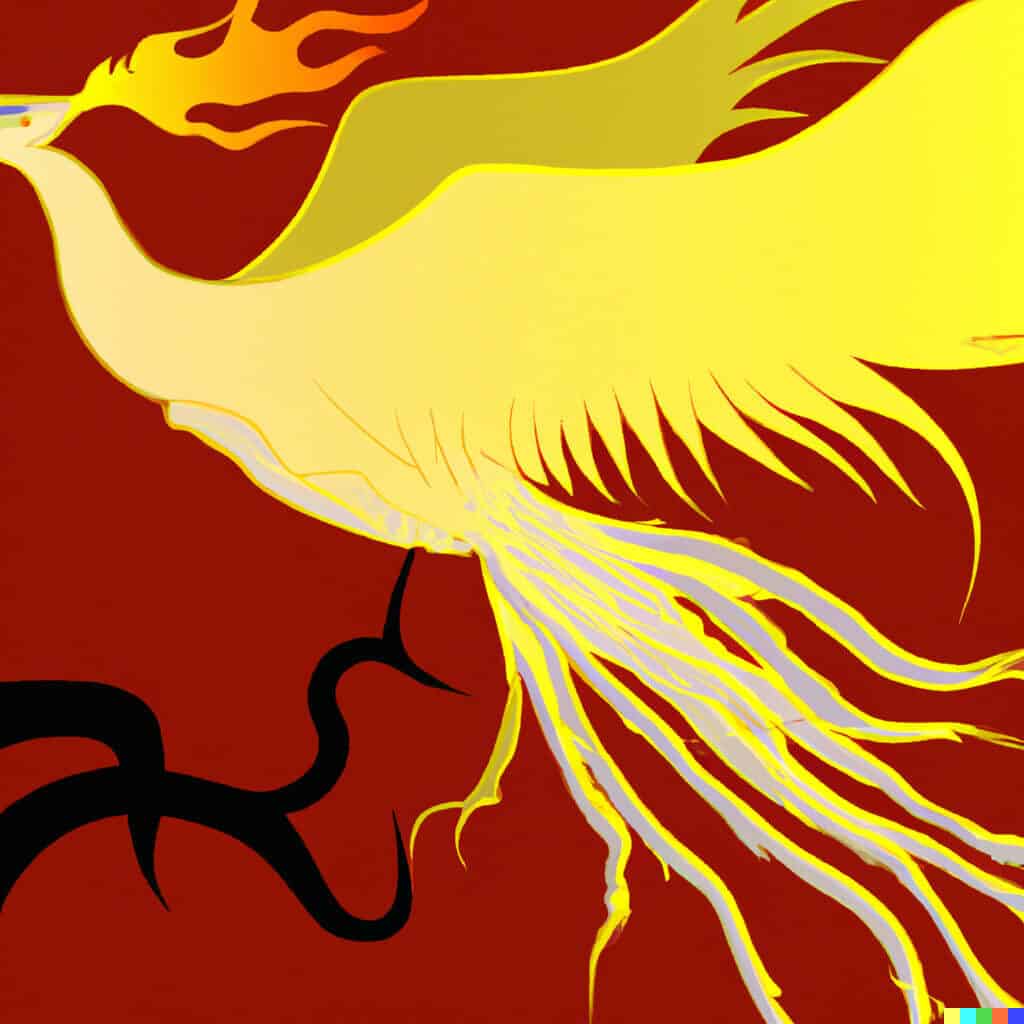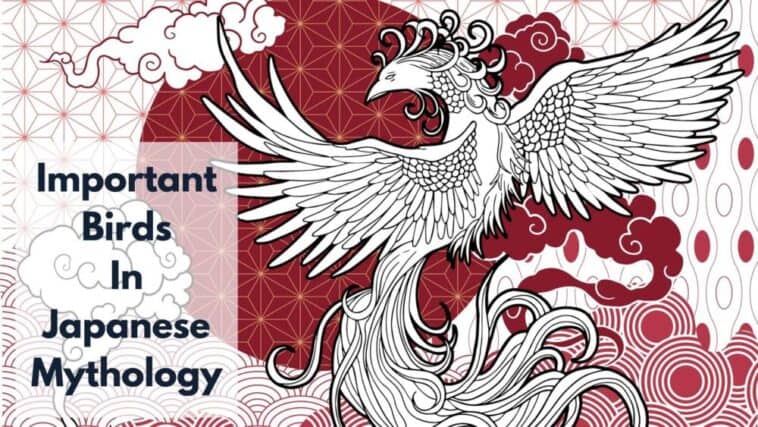Wanna learn about birds in Japanese mythology? Here are some interesting birds in japanese mythology. Check it out!
Birds have always been important in Japanese culture and mythology. They are revered for their beauty, grace, and mystique.
In Japanese mythology, birds have played an important role as messengers of the gods, bringers of good fortune, and even as symbols of the afterlife.
Let’s take a closer look at some of the most important birds in Japanese mythology.
Page Contents
Important Birds In Japanese Mythology
Phoenix (Hou-Ou)

In Japanese mythology, the Phoenix is known as the Hou-Ou (鳳凰) or the Hou-O (鳳). It is a mythical bird that is said to symbolize good luck, prosperity, and longevity.
The Hou-Ou is often depicted as a large, brightly colored bird with golden or red feathers, and is said to have a wingspan of several meters.
The Hou-Ou is believed to have the ability to rise from the ashes of its own death, which has made it a symbol of rebirth and renewal in Japanese culture.

According to legend, the Hou-Ou only appears during times of peace and prosperity, and its presence is said to bring good fortune and happiness to those who witness it.
One of the most famous stories involving the Hou-Ou is the tale of Emperor Jimmu, the legendary first emperor of Japan.
According to the legend, as Emperor Jimmu was about to embark on a military campaign to conquer the eastern part of Japan, he was visited by a Hou-Ou.
The bird perched on a nearby tree and sang a beautiful song, which inspired the emperor and his troops to march forward with renewed vigor and determination.
The Hou-Ou is said to have continued to accompany Emperor Jimmu throughout his journey, bringing good fortune and success to his army.
In modern times, the Hou-Ou is still a popular symbol in Japanese culture and can be found on everything from clothing to artwork to currency.
It is also a popular subject in Japanese literature, music, and film, and is often used as a metaphor for resilience, courage, and perseverance
Crane (Tsuru)
In Japanese mythology, the crane, known as the Tsuru (鶴), holds a special significance as a symbol of longevity, luck, and fidelity. Here’s a brief overview of the crane’s role in Japanese mythology:

According to legend, the crane is said to live for a thousand years and is considered a sacred bird in Japanese culture. In some stories, it is even believed that cranes can transform into humans and that they possess magical powers.
One of the most famous stories involving cranes is the tale of the “Crane Wife.” In this story, a poor man saves the life of a wounded crane and takes it home to nurse it back to health.
The next day, a beautiful woman appears at his doorstep, claiming to be the crane he had saved.
The woman offers to marry him on the condition that he never ask her about her past.
The man agrees, and they live happily together for several years until his curiosity gets the best of him and he asks his wife about her true identity.
She reveals that she is indeed the crane he had saved, and that she must now return to her true form and fly away.
However, she leaves behind a beautiful cloth that brings the man good fortune for the rest of his life.
In addition to its role in folklore, the crane is also a popular subject in traditional Japanese art and literature.
It is often depicted in paintings and sculptures, and is a common motif in kimono fabrics and other decorative objects.
In Japanese culture, the crane is also associated with the concept of “senbazuru,” which refers to the practice of folding one thousand paper cranes as a symbol of good luck and longevity.
This tradition is said to have originated in the story of Sadako Sasaki, a young girl who was exposed to radiation from the atomic bomb dropped on Hiroshima during World War II.
Sadako believed that if she could fold one thousand cranes, she would be granted a wish and would recover from her illness.
Although she passed away before completing her task, the tradition of folding one thousand cranes in her memory has become a symbol of peace, hope, and resilience in Japanese culture.
Sparrow (Suzume)
In Japanese mythology, the sparrow, known as the Suzume (雀), is a common bird that is often depicted in folklore and art. Here’s a brief overview of the sparrow’s role in Japanese mythology:
In Japanese folklore, the sparrow is often associated with happiness, love, and good fortune. One famous story involves a sparrow that tricks a cruel landlord into leaving his home, allowing a poor old man and his wife to move in and live happily ever after.
Another story involves a young woman who is visited by a sparrow in her dreams. The sparrow tells her to go to a specific place in the woods and dig up a certain plant.
When the woman does as she is told, she finds a rare and valuable herb that brings her great fortune and success.
In addition to its role in folklore, the sparrow is also a popular subject in traditional Japanese art and literature. It is often depicted in paintings, woodblock prints, and poetry, and is a common motif in kimono fabrics and other decorative objects.
In some traditional Japanese martial arts, the sparrow is also used as a symbol of agility and quickness and is incorporated into various techniques and movements.
Overall, the sparrow holds a special place in Japanese culture as a symbol of joy, luck, and perseverance.
Its small size and unassuming appearance belie its importance in both folklore and art, making it a beloved and enduring symbol of Japanese mythology.
Crow (Karasu)
The crow, or “Karasu” (鴉) in Japanese mythology, is a significant and culturally important symbol.
It is often depicted as a clever and mischievous trickster figure in Japanese folklore, known for its intelligence and ability to outsmart humans and other animals.
Additionally, the crow is associated with Raijin, the god of thunder and lightning, who is said to ride on the back of a crow and use thunderbolts as his weapons.
In Shinto mythology, the crow is considered one of the messengers of the gods, along with the fox and the monkey.
They are said to communicate with the gods and act as intermediaries between humans and the divine.
In certain regions of Japan, crows are even considered sacred animals and are protected by law.
Local communities may also feed and care for them.
Throughout Japanese art and literature, the crow has played a significant role, appearing in many traditional stories, poems, and paintings.
In summary, the crow’s multifaceted significance within Japanese mythology represents intellect, trickery, and divine connection, and continues to be felt today in both folklore and cultural traditions.
- Related: Sacred Eagle In Japanese Mythology
Nightingale (Uguisu)
In Japanese mythology, the nightingale, also known as uguisu, is a symbol of beauty and purity.
The uguisu is a small brown bird with a beautiful voice that sings in the early morning and late evening.
It is said that the uguisu’s song is so beautiful that it can cure illness and bring happiness.
One of the most famous stories involving the uguisu is the tale of the Emperor’s Nightingale.
In this story, an emperor hears about a nightingale whose song is so beautiful that it can heal the sick and bring joy to the hearts of those who hear it.
The emperor orders his servants to find the nightingale and bring it to him.
When the nightingale is finally found and brought to the emperor, he is overjoyed by the bird’s beautiful song.
The emperor keeps the nightingale in a cage and listens to its song every day.
However, one day the emperor receives a mechanical nightingale, which he believes is even more beautiful than the real bird.
He becomes obsessed with the mechanical bird and forgets about the real nightingale.
Eventually, the mechanical bird breaks down, and the emperor becomes ill. He remembers the real nightingale and sends for it, but the bird has flown away.
The emperor realizes his mistake and learns that true beauty cannot be replicated or bought with gold.
The uguisu is also associated with the Shinto goddess Amaterasu, who is the goddess of the sun and the universe.
According to legend, Amaterasu was so upset with her brother’s cruel behavior that she retreated into a cave, causing the world to be plunged into darkness.
The other gods and goddesses tried to coax her out of the cave, but she refused.
Finally, the goddess Ame-no-Uzume came up with a plan to lure Amaterasu out of the cave. She placed a mirror and a branch of the uguisu tree outside the cave and started dancing and singing.
The other gods and goddesses joined in, making so much noise that Amaterasu became curious and came out of the cave to see what was going on.
When she saw her reflection in the mirror, she was so surprised and amused that she started laughing, and the world was once again filled with light.
In Japanese culture, the uguisu is considered a harbinger of spring and is often featured in poetry and artwork. Its sweet and melodic song is a reminder of the beauty of nature and the importance of taking time to appreciate it.
In conclusion, birds play a significant role in Japanese mythology and culture.
From the Phoenix, symbolizing immortality and rebirth, to the Crane, representing longevity and fidelity, these birds have helped shape the Japanese perception of the world around them.
They have become an integral part of Japanese art and literature, and continue to inspire people all around the world with their beauty and mystique.
Also Read
My writing focuses on the various aspects of Japanese lifestyle, from traditional tea ceremonies and flower arrangement to modern fashion trends and pop culture. Through my articles, I aim to share my passion for Japan and provide readers with a glimpse into the rich and diverse world of Japanese culture.
I believe that the key to understanding Japanese lifestyle is to appreciate the balance between tradition and innovation. While Japan has a rich cultural heritage that dates back centuries, it is also a country that is constantly evolving and embracing new ideas and technologies.
Whether you’re interested in learning about the latest fashion trends in Tokyo, or want to explore the ancient art of calligraphy, my writing will take you on a journey through the many facets of Japanese lifestyle. So join me as we explore the beauty and complexity of this fascinating culture together!





